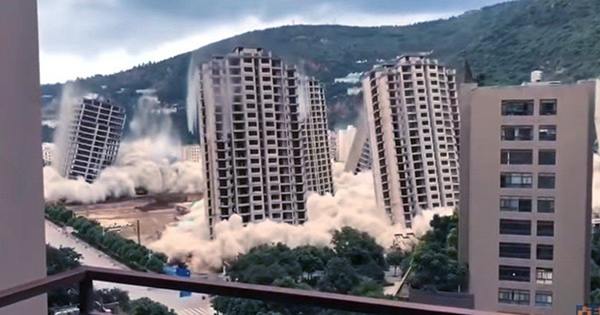What happens if you build 15 buildings quickly, but then can’t finish them after seven years? Everything is obliterated in a single apocalyptic blast.
According to Mehr News Agency, 15 skyscrapers in Kunming, China, were left incomplete for far too long and were all demolished at the same time on Friday the 27th. The structures’ basements had been inundated in rains, according to Yahoo. The planned explosion preparations lasted four days, during which time nearby stores were closed and residents were evacuated.
Despite the precautions, one structure proved to be a bit too tenacious and managed to withstand the demolitions, as shown at the end of the movie on a severe tilt. This isn’t the first time China has seen simultaneous demolitions. In 2017, 36 buildings in Zhengzhou were demolished in less than 20 seconds with the aim of transforming the area into a more desirable hub. With so many high-rise structures dotting the skylines of many Chinese cities, space is at a premium, thus destruction for refurbishment is common; while many others have outlived their useful lives and must be demolished to make way for new houses and facilities.
The Syrian government and its partner, Russia, started a major military effort in northwest Syria in April 2019 to recover the governorate of Idlib and neighboring regions, which was one of the remaining areas controlled by anti-government armed groups. The Syrian-Russian alliance displayed callous disdain for the lives of the roughly 3 million inhabitants in the area during the next 11 months, many of whom were displaced by fighting in other parts of Syria.
In violation of the laws of war, the coalition unleashed dozens of air and ground assaults on civilian objects and infrastructure, including houses, schools, healthcare facilities, and markets — sites where people live, work, and learns. In inhabited areas, they utilized cluster munitions, incendiary weaponry, and homemade “barrel bombs” to terrible effect. At least 1,600 civilians were killed in the attacks, which also destroyed and damaged civilian infrastructure and drove 1.4 million people to flee their homes.
In March 2020, the combat was brought to a halt by a ceasefire agreed by Russia and Turkey. By then, the Syrian government had retaken control of about half of the region in and surrounding Idlib, including hundreds of towns and villages that had been mostly depopulated as a result of the offensive’s population fleeing. Since then, some individuals have returned to areas still controlled by anti-government armed groups, where infrastructure has been destroyed and access to food, water, housing, health care, and education has been severely limited. The possibility of more conflict, as well as the threats to people, looms large.















